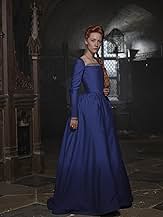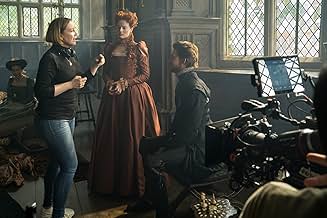मैरी स्टुअर्ट के, अपनी कज़िन इंग्लैंड की रानी एलिजाबेथ वन को ओवरथ्रो करने के प्रयास और सजा का सामना करने से पहले वर्षों की कैद को दर्शाया गया है.मैरी स्टुअर्ट के, अपनी कज़िन इंग्लैंड की रानी एलिजाबेथ वन को ओवरथ्रो करने के प्रयास और सजा का सामना करने से पहले वर्षों की कैद को दर्शाया गया है.मैरी स्टुअर्ट के, अपनी कज़िन इंग्लैंड की रानी एलिजाबेथ वन को ओवरथ्रो करने के प्रयास और सजा का सामना करने से पहले वर्षों की कैद को दर्शाया गया है.
- 2 ऑस्कर के लिए नामांकित
- 8 जीत और कुल 31 नामांकन
फ़ीचर्ड समीक्षाएं
It's only my love for Saoirse Ronan and Adrian Lester that I kept it on. It was Disney-fied in the casting area as there were no people of colour as nobleman or indeed in the court at that time. Mary's accent is not accurate as she was raised in France. And they didn't all wear black. It was like rowan atckinson's black adder. The subject matter is intense as extreme misogyny meets religious hypocrisies! Well
Shot and acted by ALL.
Mary (Saoirse Ronan) was raised in the French court. After the death of her first husband King Francis II of France, the 19 year old Scot monarch returns to her homeland to take back the throne from her Protestant half-brother. She faces opposition from her Protestant subjects under constant attack by cleric John Knox and a rival in her cousin Queen Elizabeth I (Margot Robbie). Her lineage gives her a better claim to both crowns. Elizabeth is in love with Robert Dudley but she is blocked from marrying the commoner. Mary marries Henry Stuart, an English Catholic lord, and faces rebellion from her many foes including her own husband.
I'm no history expert and even I noticed some questionable takes by the movie. This is definitely trying to paint Mary as reasonable as possible. She's almost modern with a good helping of sisterhood. It's betrayed by a couple of incidents where she keeps pushing for the English crown. It's as if the settled history keeps interfering with the script's needs. It's also questionable to have Saoirse play Scottish when Mary is probably more French than anything. Margot Robbie could do better to show Mary's disconnection with her own country. I guess Saoirse at least looks more like Mary. The political intrigue is interesting but it does get jumbled with all the characters. Some get lost in the shuffle. I also don't know if England has a black ambassador at that time. It'd be great if true. There is the ethereal meeting in the cabin. I remember hearing that the two Queens never met face to face in real life. I can accept a bit of artistic license but this movie takes a lot more than a bit. At least, the cabin finally gets to the truth of Mary's character as far as I'm concern in her final outburst. As for the actors, Saoirse and Margot do exceptional work for what is asked of them. This is a movie of many battles and intrigue but the most defining victory may be a birth. I am uncertain about the accuracy of this movie and that taints any enjoyment.
I'm no history expert and even I noticed some questionable takes by the movie. This is definitely trying to paint Mary as reasonable as possible. She's almost modern with a good helping of sisterhood. It's betrayed by a couple of incidents where she keeps pushing for the English crown. It's as if the settled history keeps interfering with the script's needs. It's also questionable to have Saoirse play Scottish when Mary is probably more French than anything. Margot Robbie could do better to show Mary's disconnection with her own country. I guess Saoirse at least looks more like Mary. The political intrigue is interesting but it does get jumbled with all the characters. Some get lost in the shuffle. I also don't know if England has a black ambassador at that time. It'd be great if true. There is the ethereal meeting in the cabin. I remember hearing that the two Queens never met face to face in real life. I can accept a bit of artistic license but this movie takes a lot more than a bit. At least, the cabin finally gets to the truth of Mary's character as far as I'm concern in her final outburst. As for the actors, Saoirse and Margot do exceptional work for what is asked of them. This is a movie of many battles and intrigue but the most defining victory may be a birth. I am uncertain about the accuracy of this movie and that taints any enjoyment.
I really wanted to love this movie. It was beautifully shot, and Ronin was, as always, very strong. And the rest of the cast was fine -- the problems with this Elizabeth were not Robbie's fault. The film was beautiful, but quite, quite dead. And it didn't flow, just a bunch of independent set pieces. Blame the writer and the director.
Historic authenticity is cast to the wind in this revisionist costume drama that feels like it was written by a freshman Women's Studies major. Directed by Josie Rourke with a screenplay by Beau Willimon, Mary Queen of Scots (2018) was based on the book Queen of Scots: The True Life of Mary Stuart by John Guy. Like many films released this year, it has strong female leads, a diverse cast, and progressive social messaging, but checking all the right boxes on the SJW playlist wasn't enough to save this film from mediocrity.
The year is 1560, and the young and beautiful Mary Tudor (Saoirse Ronan) returns home, where she is out of place in a dreary Scottish castle. Her half-brother, James, Earl of Moray (James McArdle), has been ruling as regent, alongside a bevy of colorless and perpetually-angry Protestant men. Her appearance in Scotland alarms her cousin, Queen Elizabeth I of England (Margot Robbie). Elizabeth, a Protestant, is not seen as a legitimate ruler by her Catholic subjects. She seeks to gain influence over Mary by arranging a marriage with Elizabeth's own lover, Robert Dudley (Joe Alwyn).
Instead, Mary marries the charming and charismatic Lord Henry Darnley (Jack Lowden), who pulls a Jeckyll-and-Hyde routine and becomes a drunken lecher on their wedding night. Things get complicated for the childless Queen Elizabeth when Mary becomes pregnant, producing an heir for her dynasty and strengthening her claim to the English throne. Can Mary fend off attacks from her domestic critics and convince Elizabeth to acknowledge her as England's rightful ruler?
Mary Queen of Scots couldn't decide whether it wanted to be a film about the rivalry between two queens or a revisionist biopic of its titular character, so it does neither particularly well. This ill-conceived and poorly executed film also missed a chance to let its leading ladies shine. As Queen Elizabeth, the talented Margot Robbie goes to waste as a costumed mannequin who practically disappears for the middle third of the film.
Historically, Mary Stuart was born in 1542, the only legitimate heir to Scottish King James V. She was briefly married to the King of France. After his untimely death in 1560, Mary returned to Scotland and ruled as Mary I of Scotland until 1567, when she was forced to abdicate after her second husband's murder (which her rivals accused her of orchestrating). She fled to England to seek protection from her cousin, Queen Elizabeth I, but many English Catholics considered Mary the legitimate Queen of England, so Elizabeth had her imprisoned and later executed.
There are many anachronisms and inaccuracies throughout Mary Queen of Scots, not the least of which was "colorblind casting" that falsely portrays 16th-Century England and Scotland's aristocracy as racially diverse. Mary's Scottish accent was also out of place (she grew up in France), as was her friendship with Italian courtier David Rizzio/Riccio. Most historians acknowledge Mary was probably having an affair with the man, which infuriated her Second Husband. Rizzio might have been bisexual, but he wasn't "one of the girls," as the film portrays.
Though ostensibly based on a book, this film can be considered a remake of the 1971 film by the same name. Mary, Queen of Scots (1971) was directed by Charles Jarrott and starred Vanessa Redgrave and Glenda Jackson. Like the 2018 film, the 1971 version featured a fictional meeting between the two queens and speculated that Lord Darnley and the musician David Riccio were lovers. The two films part ways, however, when it came to Mary's imprisonment. The 1971 version devotes more screen time to her 19 years in English captivity, while this version fast-forwards through it.
Mary Queen of Scots opened to mixed reviews and currently holds a 63% positive rating from critics and 44% audience favorability on RottenTomatoes. Its opening weekend took in a painful $194,777 on a $25 million budget. A successful film gets the audience invested in the story. Mary Queen of Scots ultimately failed to connect with audiences because it was more concerned with pushing the filmmaker's social perspective than making us care about who gains the English throne.
The year is 1560, and the young and beautiful Mary Tudor (Saoirse Ronan) returns home, where she is out of place in a dreary Scottish castle. Her half-brother, James, Earl of Moray (James McArdle), has been ruling as regent, alongside a bevy of colorless and perpetually-angry Protestant men. Her appearance in Scotland alarms her cousin, Queen Elizabeth I of England (Margot Robbie). Elizabeth, a Protestant, is not seen as a legitimate ruler by her Catholic subjects. She seeks to gain influence over Mary by arranging a marriage with Elizabeth's own lover, Robert Dudley (Joe Alwyn).
Instead, Mary marries the charming and charismatic Lord Henry Darnley (Jack Lowden), who pulls a Jeckyll-and-Hyde routine and becomes a drunken lecher on their wedding night. Things get complicated for the childless Queen Elizabeth when Mary becomes pregnant, producing an heir for her dynasty and strengthening her claim to the English throne. Can Mary fend off attacks from her domestic critics and convince Elizabeth to acknowledge her as England's rightful ruler?
Mary Queen of Scots couldn't decide whether it wanted to be a film about the rivalry between two queens or a revisionist biopic of its titular character, so it does neither particularly well. This ill-conceived and poorly executed film also missed a chance to let its leading ladies shine. As Queen Elizabeth, the talented Margot Robbie goes to waste as a costumed mannequin who practically disappears for the middle third of the film.
Historically, Mary Stuart was born in 1542, the only legitimate heir to Scottish King James V. She was briefly married to the King of France. After his untimely death in 1560, Mary returned to Scotland and ruled as Mary I of Scotland until 1567, when she was forced to abdicate after her second husband's murder (which her rivals accused her of orchestrating). She fled to England to seek protection from her cousin, Queen Elizabeth I, but many English Catholics considered Mary the legitimate Queen of England, so Elizabeth had her imprisoned and later executed.
There are many anachronisms and inaccuracies throughout Mary Queen of Scots, not the least of which was "colorblind casting" that falsely portrays 16th-Century England and Scotland's aristocracy as racially diverse. Mary's Scottish accent was also out of place (she grew up in France), as was her friendship with Italian courtier David Rizzio/Riccio. Most historians acknowledge Mary was probably having an affair with the man, which infuriated her Second Husband. Rizzio might have been bisexual, but he wasn't "one of the girls," as the film portrays.
Though ostensibly based on a book, this film can be considered a remake of the 1971 film by the same name. Mary, Queen of Scots (1971) was directed by Charles Jarrott and starred Vanessa Redgrave and Glenda Jackson. Like the 2018 film, the 1971 version featured a fictional meeting between the two queens and speculated that Lord Darnley and the musician David Riccio were lovers. The two films part ways, however, when it came to Mary's imprisonment. The 1971 version devotes more screen time to her 19 years in English captivity, while this version fast-forwards through it.
Mary Queen of Scots opened to mixed reviews and currently holds a 63% positive rating from critics and 44% audience favorability on RottenTomatoes. Its opening weekend took in a painful $194,777 on a $25 million budget. A successful film gets the audience invested in the story. Mary Queen of Scots ultimately failed to connect with audiences because it was more concerned with pushing the filmmaker's social perspective than making us care about who gains the English throne.
This film tells the story of Mary Stuart, the queen of Scotland int eh 1500's.
Within fifteen minutes into the film, I already lost all interest in it. The fact that the Royal Court is multi-ethnic back then is unimaginable and inaccurate, even to a person who knows only basic world history. Then, Mary addresses an effeminate man as sister? Really? Homosexuality was punishable by death those days. The story is slow most of the time, but critical plot points are just skimmed over. The fact that the supporting characters are mostly unrecognisable (except for Guy Pearce) makes the characters very confusing too. I can hardly tell who is who. It is a huge bore and a big disappointment.
Within fifteen minutes into the film, I already lost all interest in it. The fact that the Royal Court is multi-ethnic back then is unimaginable and inaccurate, even to a person who knows only basic world history. Then, Mary addresses an effeminate man as sister? Really? Homosexuality was punishable by death those days. The story is slow most of the time, but critical plot points are just skimmed over. The fact that the supporting characters are mostly unrecognisable (except for Guy Pearce) makes the characters very confusing too. I can hardly tell who is who. It is a huge bore and a big disappointment.
क्या आपको पता है
- ट्रिवियाThe first time Saoirse Ronan and Margot Robbie saw each other in character was during the scene where they meet for the first time. They rehearsed separately, and Robbie's scenes were completed the day Ronan began hers.
- गूफ़Darnley wasn't exiled to Kirk o' Field, he was sent there with the pox, for medical quarantine.
- कनेक्शनFeatured in Front Row: एपिसोड #3.3 (2018)
टॉप पसंद
रेटिंग देने के लिए साइन-इन करें और वैयक्तिकृत सुझावों के लिए वॉचलिस्ट करें
- How long is Mary Queen of Scots?Alexa द्वारा संचालित
- Is this fiction or history?
विवरण
- रिलीज़ की तारीख़
- कंट्री ऑफ़ ओरिजिन
- आधिकारिक साइटें
- भाषाएं
- इस रूप में भी जाना जाता है
- Las dos reinas
- फ़िल्माने की जगहें
- Aviemore, Highland, स्कॉटलैंड, यूनाइटेड किंगडम(on location)
- उत्पादन कंपनियां
- IMDbPro पर और कंपनी क्रेडिट देखें
बॉक्स ऑफ़िस
- बजट
- $2,50,00,000(अनुमानित)
- US और कनाडा में सकल
- $1,64,68,499
- US और कनाडा में पहले सप्ताह में कुल कमाई
- $1,94,777
- 9 दिस॰ 2018
- दुनिया भर में सकल
- $4,67,12,809
- चलने की अवधि2 घंटे 4 मिनट
- रंग
- ध्वनि मिश्रण
- पक्ष अनुपात
- 2.39 : 1
इस पेज में योगदान दें
किसी बदलाव का सुझाव दें या अनुपलब्ध कॉन्टेंट जोड़ें






































